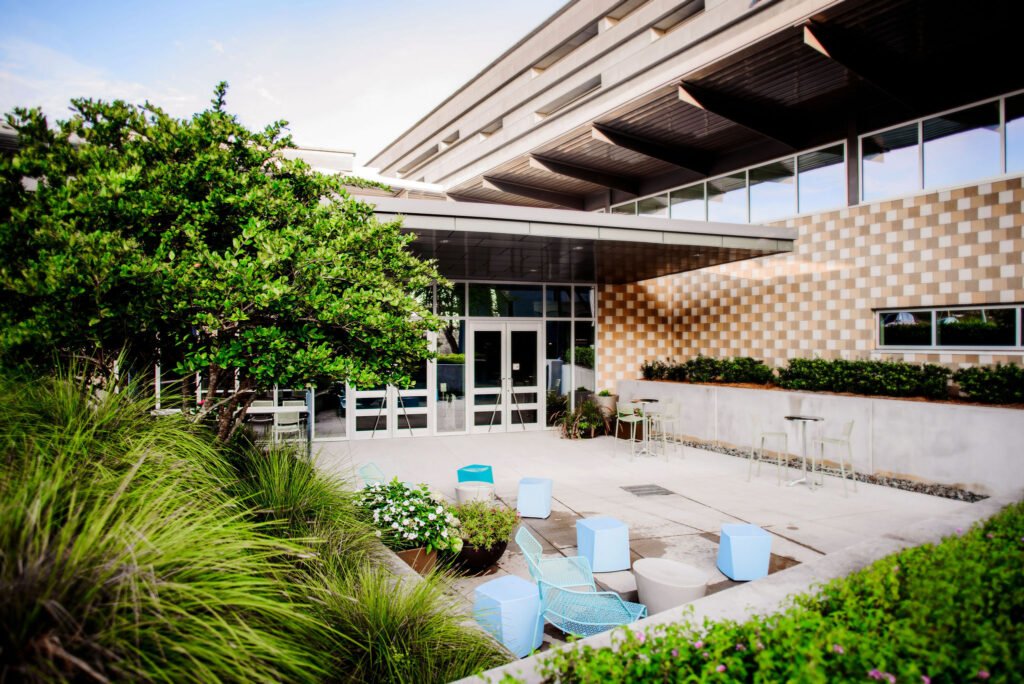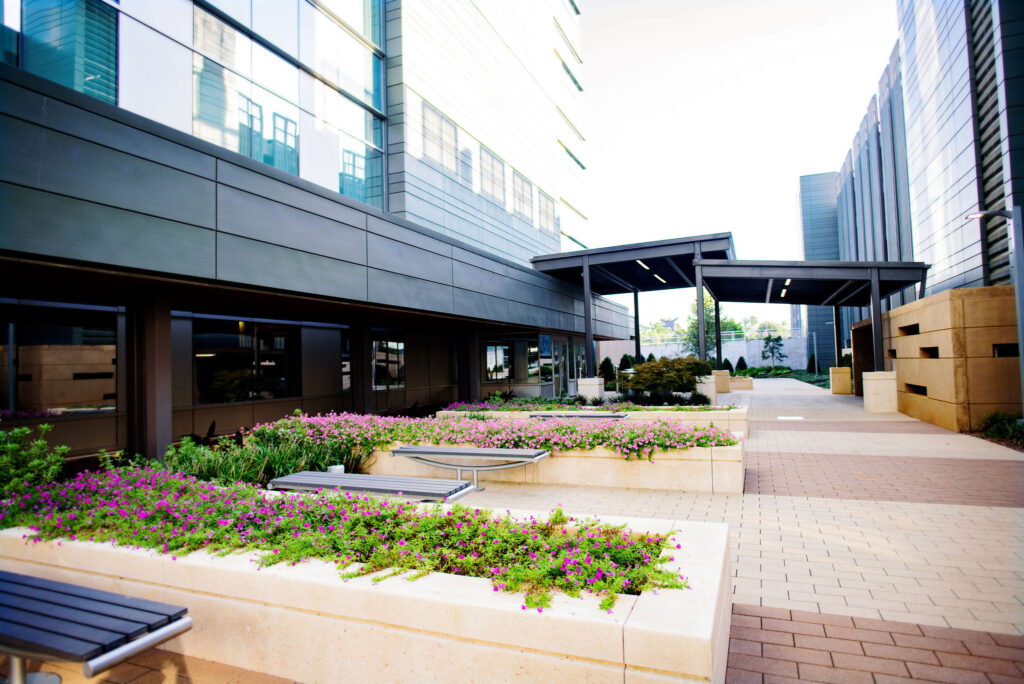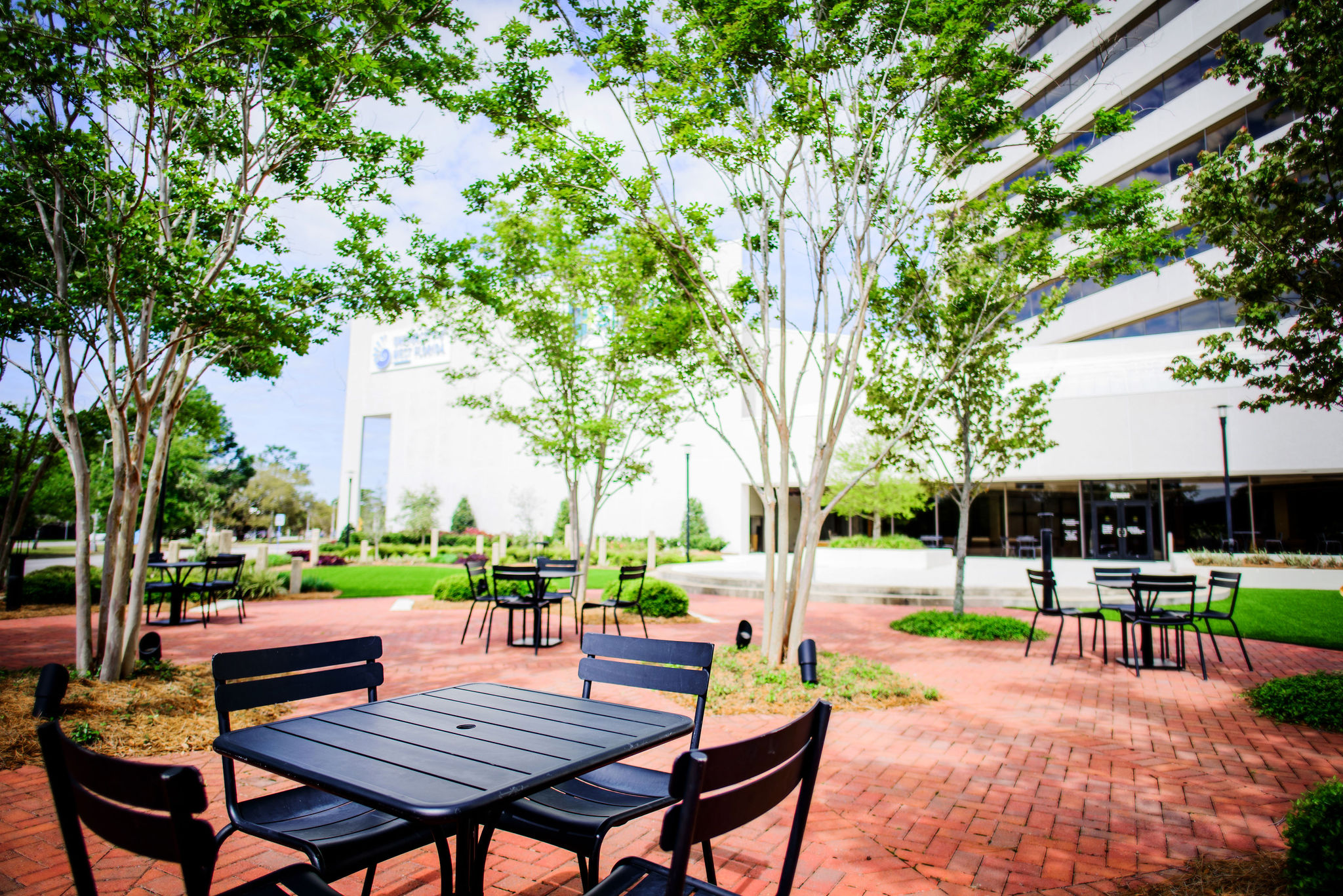Golfweek Features Jerry Pate Design and Teeth of the Dog - Read More
While the idea has been around for at least a decade, the emerging trend of outdoor workspaces really gained traction during the pandemic. Suddenly the fresh air and open spaces became more than a pleasant workday distraction. They became regarded as an excellent alternative to enclosed workspaces for health-conscious employees. Let’s talk about this trend, which continues to gain traction.
What Is an Outdoor Workspace

Outdoor workspaces can be simple or elaborate. Many office buildings and corporate parks have some sort of green space included in the design, whether it’s a patio, terrace, balcony or rooftop. Outdoor workspaces take it a step further by adding benches, tables, workstations and Wi-Fi connectivity.
The Benefits of Being Outdoors
As we mentioned a moment ago, the trend towards outdoor workspaces was accelerated by a focus on healthy work environment alternatives. The science behind what fresh air, sunlight and natural surroundings can do for us has been around for awhile, though. Spending time outdoors can reduce stress, enhance mood, increase focus and have an overall positive impact on employee health and performance.
Exposure to sunlight has been found to have a number of health benefits. Sunlight is the primary source of vitamin D, which is essential for calcium absorption, bone health and immune function. According to a 2006 World Health Organization (WHO) report, lack of sufficient vitamin D is most often linked to lack of exposure to outdoor sunlight and a deficiency may result in musculoskeletal disorders, immune diseases and even cancer.
There is science behind why sunlight makes us feel better, too. By triggering the release of serotonin, sunlight is indirectly responsible for promoting a feeling of well-being and reducing depression. Other research has shown that sunlight exposure can lower blood pressure, enhance cognitive function and even stimulate the production of hormones that can help with weight loss.
Why Outdoor Workspaces Are Trending
Putting all these benefits together with the upheaval in working environment options that the shift to remote work policies caused, it’s easy to see why it’s a good idea for employers to offer outdoor workspaces. Put simply, many employees have had a taste of the flexibility offered by working from home. Whether using a laptop on the patio, taking a call while walking around the neighborhood or just enjoying a quick break, they have come to appreciate options that involve fresh air.
As a result, outdoor workspaces have become an important tool for attracting and retaining top talent. They have also proven to be a profitable opportunity for developers and property managers. Prioritizing the availability of attractive outdoor workspaces results in higher demand, increased rents and better occupancy rates. Outdoor workspaces have emerged as great value enhancements for commercial properties.
Types of Outdoor Workspaces

Options for outdoor work areas are somewhat limited by the type of real estate an office building occupies. Office parks typically offer the greatest flexibility, with large expanses of open space between buildings or immediately adjacent to them. More urban buildings may be limited to terraces, balconies or rooftop options. In any case, the outdoor amenities are often spaces that are shared between multiple tenants.
Another trend that has been emerging in recent years is that of spaces shared between different types of buildings. In many metropolitan areas, office, residential and retail buildings are being developed around shared outdoor spaces. These areas can then be used by residents and office workers alike, enhancing the value of both real estate types.
Features and Amenities for Outdoor Workspaces
Creating an attractive and functional outdoor workspace requires research and planning. Carefully examine and incorporate local climate and surroundings into the design. Strive to balance aesthetics and functionality for an inviting environment that is still fully effective as an outdoor workspace.
Natural elements are an important ingredient that help create an environment that feels organic and inviting. The goal is to provide a calm and peaceful escape from the typical office environment. Plenty of greenery, native plants, water features and natural materials help to achieve a serene setting.
Features to Consider
Comfort and functionality is important, too. Employees will not use a space that is not conducive to getting work done, or causes discomfort while doing it. Even though the space is open by design, there should be an element of privacy and security involved. Some popular elements of outdoor workspaces include:
- Seating options – Benches, padded chairs and outdoor sofas provide a range of seating opportunities.
- Seating Clusters – Inviting gathering areas provide ideal opportunities for collaboration, creative discussion and brainstorming.
- Tables – Low tables provide a place to sit with a drink, while higher tables give employees a better option for working or enjoying lunch.
- Communal Tables – Whether low or high-top, tables large enough for a group of employees provide space to collaborate or enjoy a meal together.
- Office Essentials – The inclusion of whiteboards, portable workstations and even mobile displays can create an outdoor workspace that is on par with a conference room.
- Weather Protection – Umbrellas, pergolas, canopies or shade sails are essential for protection from rain and sun. Outdoor heaters can also help to extend the usable season in cooler areas.
- Power and Connectivity – Weatherproof power outlets and robust Wi-Fi availability help to ensure that working outdoors allows the same productivity as working indoors.
- Privacy and Security Features – Frosted glass panels, living walls or high hedges can add a layer of privacy to outdoor work areas. Cameras and other security devices add a sense of security.
- Noise Reduction – Living walls and sound absorbing panels can help to reduce traffic or construction noise as well as provide privacy.
Resilience and Versatility
Choose furnishings for outdoor workspaces with resilience and versatility in mind. Easy-to-move tables and chairs invite employees to create comfortable and functional workspaces. Select materials that are low-weight, yet sturdy enough to survive the elements while retaining a good appearance.
An interesting design trend that is becoming more popular is that of transitional workspaces. These building designs offer the ultimate in versatility with sliding window walls or overhead door systems that open onto an outdoor area when weather permits, but remain closed on cold or rainy days.
Outdoor Workspace Experts
Outdoor workspaces have gone from a nice feature to a nearly must-have amenity for businesses that want to attract and retain the best and brightest employees. Let us show you how Jerry Pate Design can help you create a welcoming, calming and functional outdoor workspace.

